Whether for work or personal purposes, you or your team members will likely need to access your computer without being physically present in front of it. This might be because you’re working from home or in a temporary office, working abroad, or simply spending a lot of time commuting.
In recent years, remote access software and unattended access tools have become more advanced. Besides desktop and screen sharing, many tools can now conduct file transfers and offer secure remote computer access. With more people working from home than ever, having the right remote desktop access software has become critical for businesses. AnyDesk is a well-known remote desktop software solution, but if you’re still researching the best option, you may wonder if there are alternatives better suited to your requirements.
This article explains the basics of AnyDesk and helps businesses looking for alternatives to AnyDesk by providing a list of pros and cons of the most effective remote support tools available in 2025.
Is there anything better than AnyDesk?
Key features to look for in AnyDesk alternatives
- SolarWinds Dameware Remote Everywhere (DRE)
- SolarWinds Dameware Remote Support (DRS)
- Chrome Remote Desktop
- Microsoft Remote Desktop
- Parallels Access
- TeamViewer
- AirDroid
- Zoho Assist
- NoMachine
- Splashtop
Getting Started With a Remote Desktop Connection AnyDesk Alternative
Is there anything better than AnyDesk?
AnyDesk is designed as a lightweight remote assistance and home office tool appropriate for large or small companies. It’s intended to be useful for software vendors or app developers looking to solve customer or client problems remotely. It also lets users connect from home to their office computers using the Unattended Access feature. Users gain features such as file transfer, remote printing, and session recording.
AnyDesk is built to offer high performance and security. In terms of performance, AnyDesk users can expect frame rates of 60 fps for most internet connections, though the software is built for low latency, even with low bandwidth. AnyDesk also claims its DeskRT codec feature, which compresses and transfers images, is unique among competitors. AnyDesk uses TLS 1.2 technology and RSA 2048 asymmetric key exchange encryption for security and can “whitelist” trusted users.
If you choose AnyDesk, you can expect flexibility and compatibility with Linux, Windows, MacOS, FreeBSD, iOS, Android, and the mobile app. Users can adjust some of the software’s features to suit their brand identity. The tool is also scalable and charges only for active “seats.” While you can use AnyDesk as a cloud-based tool, it’s also possible to set up and use an Enterprise Network instead.
Key features to look for in AnyDesk alternatives
Ensure the remote desktop software you choose aligns with your personal or business requirements. Consider key factors such as:
- Cross-platform compatibility: Check that your software provides seamless access and supports MacOS, Linux, Windows, and mobile OS such as iOS or Android.
- Security protocols: The software you choose should have advanced encryption standards (e.g., AES-256, TLS 1.2), two-factor authentication, and secure session logging for safe data transmission.
- File transfer: Your remote desktop software should be able to transfer files across devices securely.
- Performance: The software should have features such as low-latency connections, high frame rates, and efficient bandwidth usage for a smooth user experience.
- Scalability: The software should have flexible pricing and features that can grow alongside your business.
- Mobile app: If you want to access the application remotely, the remote desktop software should have a fully functional mobile app.
- Additional tools: Features such as multi-monitor support, session recording, ticketing systems, VoIP, and admin tools for IT management should be present.
Selecting a tool with these capabilities will ensure it will cater to your unique requirements. On that note, let’s discuss the top AnyDesk alternatives.
Top Alternatives to AnyDesk
1. SolarWinds Dameware Remote Everywhere (DRE)
SolarWinds® Dameware Remote Everywhere (DRE™) is a comprehensive, all-in-one, web-based remote computer access solution with many features. While AnyDesk doesn’t specify connection speed, DRE is designed to let you establish active remote sessions typically in less than eight seconds, potentially saving you time otherwise spent creating connections with workstations.
DRE is also designed as a secure remote access tool, but unlike AnyDesk, it uses FIPS 140-2 validated encryption. DRE uses advanced AES-256 encryption protocols (the foundation of TLS 1.2, used by AnyDesk). AnyDesk and DRE both offer multi-factor authentication options.
Unlike AnyDesk, which allows user support but doesn’t include built-in IT service management features, DRE has a lightweight ticketing system that lets you monitor end-user requests and resolve issues quickly and easily as they arise. Both DRE and AnyDesk function as remote computer-to-computer access tools, with support for all major operating systems, whether you’re looking for an AnyDesk alternative for MacOS or Windows.
With DRE, support technicians can connect with your users through in-session or pre-session communication, using VoIP or initiating video calls (not included in AnyDesk). As in AnyDesk, live chats can be established without interrupting active sessions, allowing you to communicate seamlessly and in real time. To help you keep track of communication between you and your users, messages are saved automatically to safe and searchable session logs, similar to AnyDesk.
DRE is an easy-to-use AnyDesk alternative that, like AnyDesk, is designed to scale with your company as it grows. This makes it ideal for even small organizations. However, DRE might not be the best fit for your company if you’re only looking for a basic remote access solution. This AnyDesk alternative offers an all-in-one solution plus help desk and ticketing features.
Here’s a brief overview of DRE’s pros and cons:
Pros:
- Lightweight ticketing system
- Useful in-session features
- Support for multi-level permissions and two-factor authentication
- Mobile application
Cons:
- Perhaps not suitable for businesses that already have a help desk and are only looking for a remote desktop solution
A 14-day free trial is available. Pricing is available on the home page.
2. SolarWinds Dameware Remote Support (DRS)
SolarWinds Dameware Remote Support (DRS) is another popular SolarWinds remote desktop connection AnyDesk alternative, designed to integrate with help desk software. This solution delivers quick, easy, and safe remote access and control capabilities, helping you get to the root cause of problems in as little time as possible. Like AnyDesk, DRS provides multi-platform remote access to laptops and servers, including Windows, Linux, and macOS. This AnyDesk alternative is Android and iOS compatible and comes with an intuitive mobile application for establishing remote connections through your mobile devices.
One difference between AnyDesk and DRS is that DRS is explicitly designed to offer more built-in features for remote admins. While AnyDesk emphasizes features such as file transfer and remote printing, you can use the remote access capabilities in DRS to copy and delete files, view and clear event logs, start/stop services and processes, reboot systems, and more. This could simplify your team’s IT remote support administration activities, reducing the need to make house calls to troubleshoot user problems. DRS is a safe remote desktop connection tool with advanced authentication methods. Like AnyDesk, it includes the option of using smart card sign-in to enforce multi-factor authentication in sensitive environments.
This flexible and complete solution allows you to deliver remote support anywhere and anytime. As with AnyDesk, you can create safe over-the-internet remote connections both inside the LAN and across the internet. Because of this, DRS is a good option for companies with employees who are likely to be working offsite.
Like DRE, DRS is an all-in-one remote access and systems management suite of tools. If you’re looking for a tool with fewer features to complement rather than replace the tools you already use, then DRS may not be the right AnyDesk alternative for your business.
Pros:
- Two-factor authentication
- Remote access mobile application with support for Android and iOS
- Useful admin features for pinpointed access
Cons:
- Less suitable for businesses looking for a narrower suite of tools
A 14-day free trial of SolarWinds DRS is available for download.
3. Chrome Remote Desktop
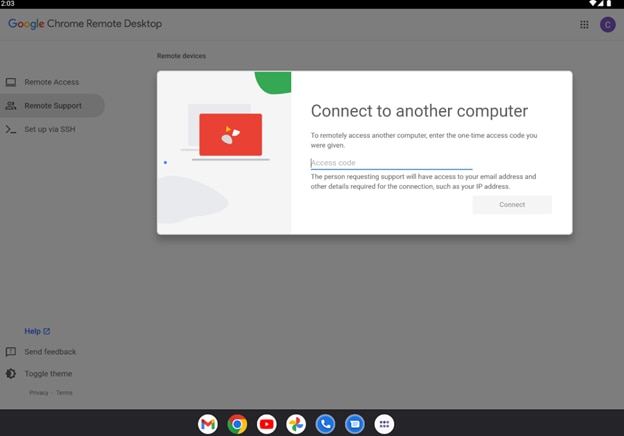
Chrome Remote Desktop is among the most popular remote desktop connection AnyDesk alternatives. If you simply want to share your screen quickly and easily, it’s a straightforward option. However, if you’re looking for an enterprise-grade remote desktop tool with a fully functional mobile application—like AnyDesk—it may not suit your needs.
The tool can be installed by users as an application from the Chrome Web Store on their computer or from the Google Play app store for an Android mobile device. While Chrome Remote Desktop is built to offer enterprise-grade performance and accessibility, the mobile application doesn’t provide the same level of functionality as the desktop tool. This limits your ability to use the solution from mobile devices. With AnyDesk, both the mobile and computer tools are highly functional, and you can download them from their website. Like AnyDesk, the Chrome application supports most major platforms, including Mac, Windows, and Linux.
Pros:
- Simple and fast
- Multi-platform
Cons:
- Limited functionality
This AnyDesk alternative is free, making it an affordable option, but it may not be entirely suited to business use.
4. Microsoft Remote Desktop

Microsoft Remote Desktop is among the most notable free competitors of AnyDesk because it’s well known and easy to use. However, it is generally more limited in functionality than AnyDesk. This solution works similarly to Chrome Remote Desktop—you simply install the client on your computer and, if you’d like to use the mobile application, download the app from your mobile device’s app store. This will allow you to connect your devices and establish remote access through video and audio streaming (like AnyDesk). A key benefit of using Microsoft Remote Desktop is that you don’t need to install Google Chrome to use this tool on Windows devices.
Although the Microsoft alternative to AnyDesk can facilitate remote access to desktops reasonably easily, its functionality is limited. For instance, you can only create a connection profile or search for an existing one to connect to it. Microsoft Remote Desktop can also be inflexible because it doesn’t allow you to modify the experience themes or settings.
Pros:
- Google Chrome installation isn’t necessary
- Simple and easy setup
Cons:
- Limited functionality
- Inflexible
5. Parallels Access
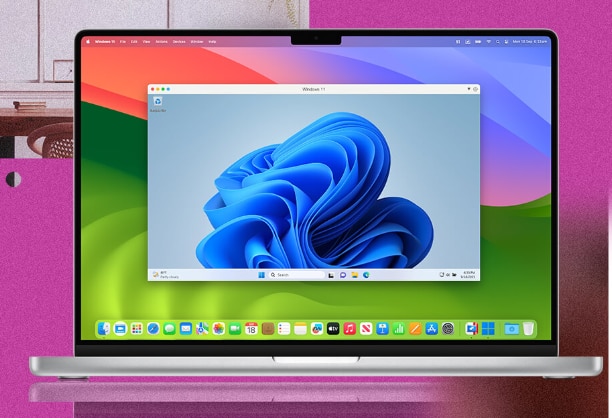
If you’re looking for an AnyDesk alternative that is effective at establishing access from a mobile device, then Parallels Access may be a good option. This tool was designed specifically for remote computer access from mobile devices, and its mobile application is highly functional. Parallels Access features a unique, user-friendly mobile user interface, with support for iPad multitasking and full-screen applications, Samsung DeX, and S Pen. AnyDesk is not mobile first but offers a widely compatible mobile application.
One of the best things about this solution is its clean user interface. Instead of showing your desktop screen on your mobile device, the Parallels Access mobile application presents a modified, mobile-friendly version. Although this tool supports connections between computers, most of its capabilities are mobile-centric.
Parallels Access offers several features similar to AnyDesk, such as screen sharing, file transfer, and session chat. However, it doesn’t let you initiate remote control of another computer from your mobile device, which AnyDesk allows. The security features also differ, as Parallels Access doesn’t offer smart card authentication.
Pros:
- Excellent mobile application
- Support solution for iPad multitasking
- User-friendly interface
Cons:
- Limited computer-to-computer access capabilities
A free trial of Parallels Access is available.
6. TeamViewer
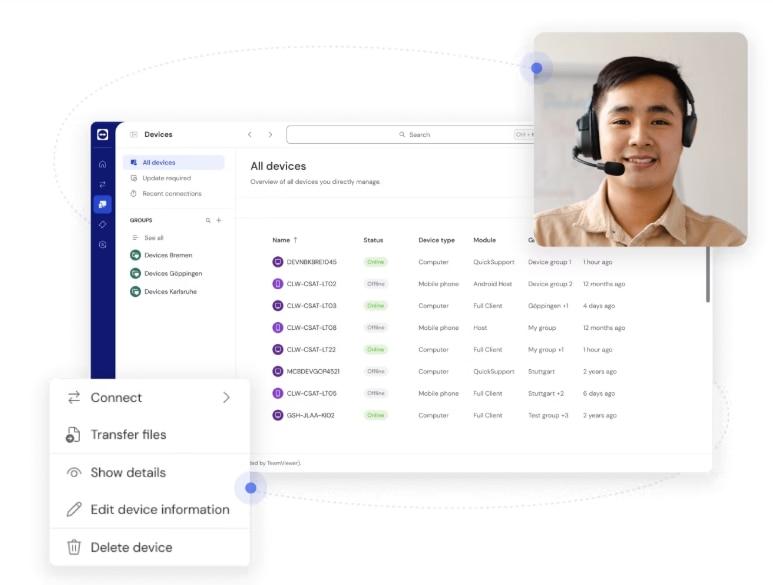
TeamViewer is another popular remote desktop application with remote access capabilities. Like AnyDesk, TeamViewer offers a mobile application for connecting to your computer from your mobile device, and although the setup for TeamViewer is a little complex, the app itself is simple and functional.
TeamViewer offers many sophisticated features similar to AnyDesk, including file transfers in both directions, real-time sound and HD video transmission, and enterprise-grade encryption protocols with two-factor authentication. However, TeamViewer emphasizes more remote control software features than AnyDesk. You can connect to multiple computers simultaneously, have an integrated service desk, use VoIP, and more. Unlike AnyDesk, the app is free for personal use, but you’ll need to pay for a subscription if you want to use it for your business.
Pros:
- High-security encryption
- Real-time sound and HD video transmission
- Support for file transfers in both directions, plus more useful features
Cons:
- Complicated setup
A 14-day free trial of the business edition of TeamViewer is available.
7. AirDroid
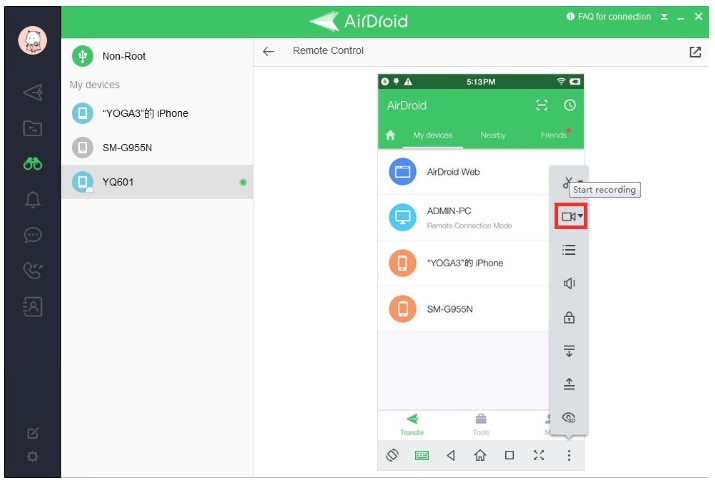
AirDroid is an all-in-one file- and multi-screen sharing solution. This tool lets you access numerous devices simultaneously from almost anywhere, supporting all major operating systems. AirDroid allows you to manage your computer from a mobile device and lets you pick up calls and send messages from your desktop using the mobile application. However, one fallback of AirDroid is a significant delay when sending SMS messages via a desktop.
Other key AirDroid features include phone screen recording and screen sharing from both sides, with many customizable settings. Unlike AnyDesk, AirDroid allows you to make or receive calls on your computer and supports notification sharing for all connected devices, which ensures you’re kept in the loop. Both tools allow for encrypted file transfer. To keep you safe, AirDroid provides secure backup and synchronization for your phones and desktop computers.
AirDroid is a personal-use tool for home offices, with AirDroid Business as an option to allow businesses to control Android devices remotely. Only the Business version includes two-step verification, an admin console, and other remote control features. Both AnyDesk and AirDroid Business are scalable solutions (AirDroid for personal use is limited to four or 10 devices, depending on your plan). All versions of AirDroid have more limited compatibility options than AnyDesk.
Pros:
- Safe backup and synchronization
- Screen recording and sharing from both sides
- Customizable settings
Cons:
- Limitations in the personal version
- Limited compatibility
You can download a free 14-day trial of AirDroid business edition here.
8. Zoho Assist
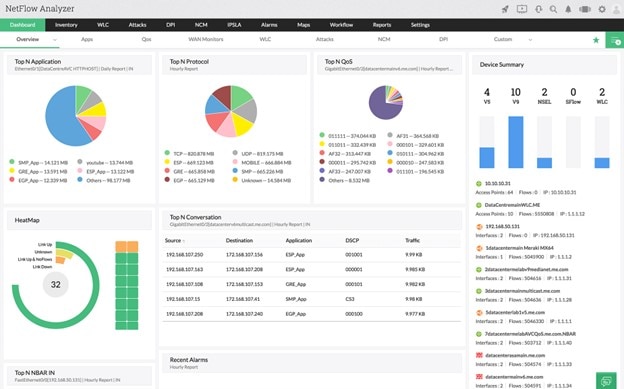
Zoho Assist is a cloud-based remote desktop software. It is designed for support teams, managed service providers, and IT professionals. The software offers both unattended access and remote support, enabling users to access computers or troubleshoot devices without user intervention. The tool supports MacOS, Windows, Linux, Android, and iOS. It provides voice and video chat, secure file transfer, and session recording. All these features make it an ideal choice for remote assistance.
Pros:
- Advanced security protocols, including multi-factor authentication and AES-256 encryption
- Integration with other Zoho products for enhanced productivity
- User-friendly interface
- Affordable pricing plans for small and medium-sized businesses
Cons:
- Limited features in the free version
- Learning curve for the advanced functionalities
Pricing:
There is a free plan for personal use. Premium plans start at $8 per month for one technician.
9. NoMachine
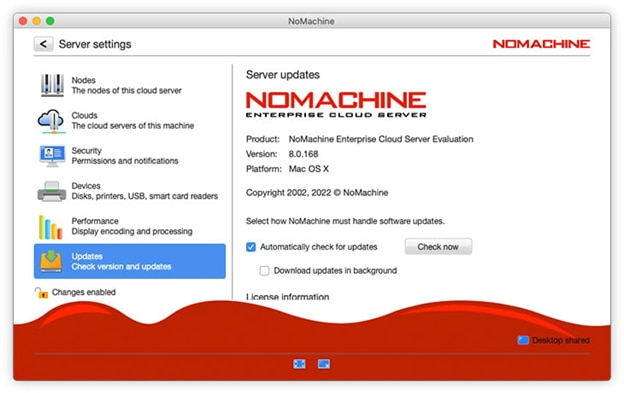
NoMachine is another notable, high-performance remote desktop software. It is popular for providing businesses and individual users with seamless remote access. Also, NoMachine is known for its responsiveness and speed. The software uses NX technology for low-latency connections and provides smooth video streaming, even if your network bandwidth is low. Not only that, but the software also offers cross-platform compatibility and supports all major operating systems.
Pros:
- Fast and smooth performance, even for resource-consuming tasks such as video editing
- Core features available in the free version
- Encrypted connection focusing on privacy
- Support for multiple platforms, including Raspberry Pi
Cons:
- Challenging advanced setup for non-technical users
- Fewer features for IT teams than competitors
Pricing:
The personal version is free to use. The enterprise version, with added features, starts at $44.50/year per user.
10. Splashtop
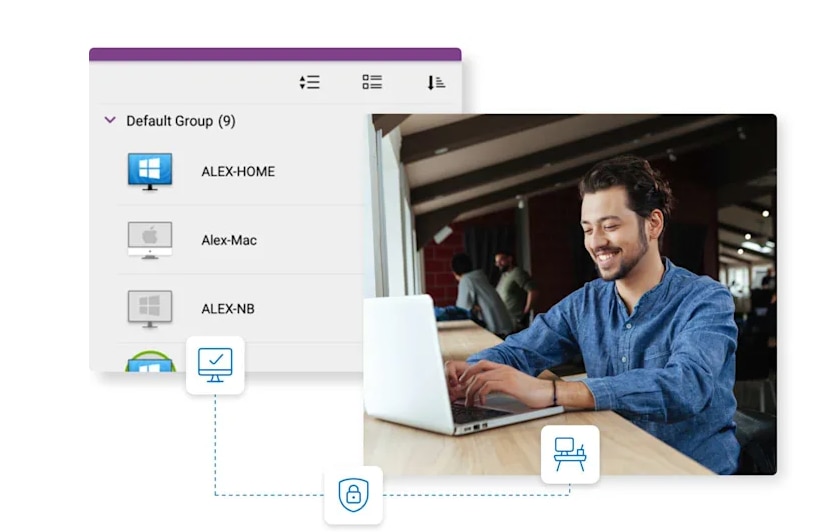
Splashtop is an AnyDesk alternative and is one of the more well-known remote desktop connection tools. Multiple versions of Splashtop are available, including editions for school and classroom, personal, business, and enterprise uses. Some versions are pricier than others.
Splashtop is a powerful remote desktop connection AnyDesk alternative, featuring some tools included in AnyDesk—such as remote print, chat, and session logging—and some features that aren’t, including drag-and-drop file transfer, multi-to-multi-monitor support, and auto-login. However, some reviews note issues with how the display functions, so starting with a free trial may make sense. One unique feature Splashtop provides is Active Directory integration, unlike AnyDesk. However, the security protocols are similar, as it uses TLS and AES-256 encryption.
Pros:
- Multi-device compatibility
- File transfer with drag-and-drop interface
- Session recording
Cons:
- Confusing visual display, according to some reviews
You can access a free trial of Splashtop here.
Getting Started With a Remote Desktop Connection AnyDesk Alternative
Hopefully, this review of the best AnyDesk alternatives will save you time by giving insight into the most popular and cost-effective tools on the market in 2025. Overall, we highly recommend SolarWinds DRE and DRS. These solutions offer numerous powerful capabilities and are intuitive, making them suitable for both beginners and experienced pros. They’re also highly scalable and suitable for enterprise use, making them a good choice for small and large businesses. You can access a free trial of DRE here and a free trial of DRS here.
If you’re still not sure which of these AnyDesk alternatives is right for you, take advantage of their free trials. No matter your reasons for choosing an AnyDesk alternative, one of the solutions featured in this list should meet your business-specific needs



